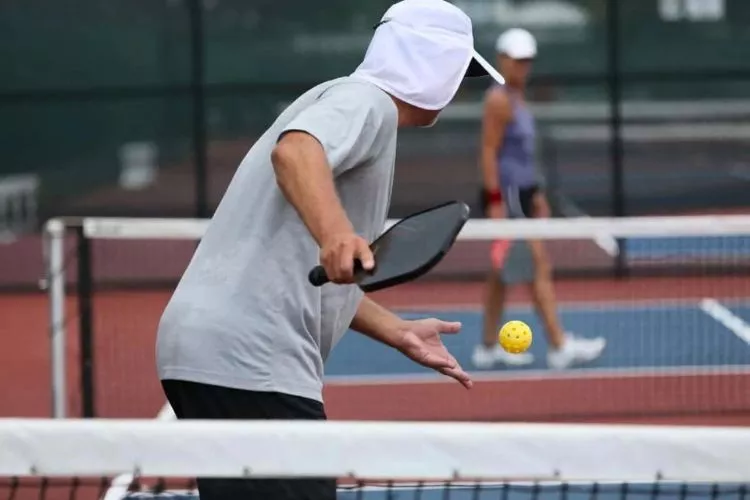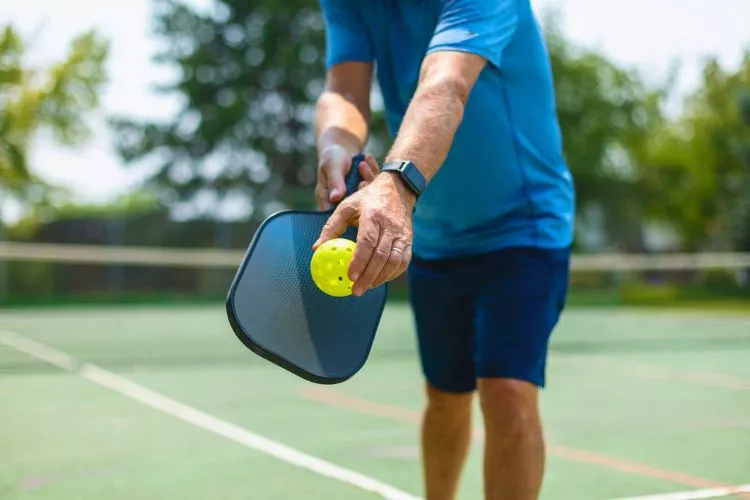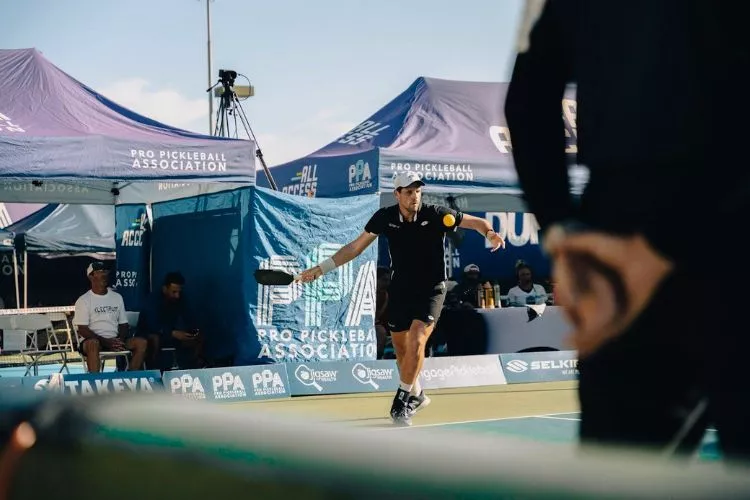Pickleball is a fun game with unique rules. One talked about the issue? The serve, especially the sidearm one.
So, is a sidearm serve legal in pickleball? This article clears your doubts.

It dives into the rules and investigates the legality of the sidearm serve. Whether you’re a pickleball newbie or a seasoned pro, stick around to get your answer.
Is a sidearm serve legal in pickleball?
Pickleball has a hard rule on serves. Underhand only. But does this rule out a sidearm serve? No, but it’s tricky.
A sidearm serve in pickleball is legal. But it must follow the guideline of an underhand serve. This means the paddle head must be below the wrist when it strikes the ball.
The swing must also start from or below the server’s waist. This rule makes a sidearm serve challenging.
Most sidearm serves naturally occur above the waist. It needs more practice to lower the starting point.
So, yes to sidearm serves. Just ensure it respects the rules of an underhand serve.
Pickleball Serving Rules: Scoring, Faults, and Boundaries
Pickleball is a growing sport that blends elements from tennis, badminton, and table tennis. Serving is a vital part of the game.
Understanding serving rules covers scoring, faults, and boundaries. This article helps players grasp these key rules.

Scoring in Pickleball
In pickleball, only the serving team can score points. The team scores when the receiving team commits a fault.
Games are played to 11 points, but the team must win by a two-point margin. In tournaments, matches can go up to 15 or 21 points.
Pickleball can be played as singles or doubles. In doubles, the teams rotate serves in a two-server system.
The first server serves until a fault occurs, then shifts to the second server. Once both servers fault, the other team takes their turn.
Pickleball Serving Faults
Faults in pickleball occur in various situations. The server must abide by the rules to avoid faults. Some common serving faults include:
- Stepping on or over the baseline: The server must keep both feet behind the baseline during the serve. Stepping on or over results in a fault.
- Serving from the wrong court: In doubles, the server must serve from their correct court into the diagonal opponent’s court. Failing to do so results in a fault.
- Not clearing the net: The serve must go over the net and land in the correct service court. If the ball does not clear the net, it is a fault.
- Landing the serve in the kitchen: If the served ball lands within the non-volley zone (the kitchen), it is a fault.
- Underhand serve rule violation: For a legal serve, the paddle head must be below the wrist, and the swing should start from or below the server’s waist. Breaking these rules results in a fault.
- Hitting the ball twice: If the server hits the ball twice during the serve, it is a fault.
Pickleball Serving Boundaries
When serving, the ball must land within specific boundaries. Here are the essential boundaries rules:
- Service courts: The serve must land within the diagonal opposite service court. The service court is the area within the baseline, net, and sidelines, excluding the kitchen.
- Non-volley zone: Also known as the kitchen, this is a 7-foot deep area on each side of the net. The serve must clear the non-volley zone to be valid.
- Centerline: In doubles, servers must serve from the correct court. The centerline runs through the middle from the net to the baseline. The server must use the correct court depending on the serving turn and score.
Additional Key Rules
Here are a few essential rules for a better understanding of pickleball serving:
- The ‘Two-Bounce’ Rule: After the serve, both teams must let the ball bounce once before hitting a volley. This means the receiving team lets the ball bounce before the return and the serving team allows the return to bounce before their next hit.
- Initial Serve: The initial serve of the game is always by the first server of the team on the right side. As the game proceeds, players take turns serving and switch sides based on the score.
- Calling the Score: Before each serve, the server must call the score. The score includes the serving team’s score first, then the receiving team’s score, followed by a “1” or “2” to represent the first or second server.
- One Serve Attempt: Servers get one attempt per serve. If the ball is missed or if any fault occurs, the serve is lost, and the other team gets the chance to serve.
- Carrier: A carrier happens when the server’s paddle does not strike the ball cleanly. Instead, it moves with the ball for a short distance before releasing it. A carrier serve is considered a fault.
Understanding serving rules is crucial to playing pickleball at any level. The summary of these rules includes scoring, faults, and boundaries.
As players become familiar with these rules, they can better display their skills and enjoy the game.
Serve Variation Strategies in Pickleball
Pickleball serves play a vital role in the game. Many styles can help you get an edge. Each type of serve has pros and cons. This article focuses on serve variation strategies in pickleball.

Deep Serve
The deep serve is a common strategy. Players aim to hit the ball high and deep into the opponent’s court. This strategy’s goal is to push the receiver back and limit their shot options.
Advantages
✅ Forces opponents away from the kitchen
✅ Limits receiver’s shot choices
Advantages
❌ Easier for opponents to return if it lacks power
❌ Less control and accuracy
Soft Serve
A soft serve is hit gently, landing close to the non-volley zone. The strategy is to catch the opponent off-guard and make them move towards the net.
Advantages
✅ Surprises opponents
✅ Encourages mistakes from the receiver
Advantages
❌ Easier to attack if the receiver anticipates it
❌ Less effective if opponents are quick
Power Serve
The power serve focuses on hitting the ball with speed to challenge the receiver. Players use forceful swings to hit the ball hard, making it difficult to return.
Advantages
✅ Puts pressure on the receiver
✅ Can cause errors from the opponent
Advantages
❌ Can be less accurate
❌ Can lead to more faults
Spin Serve
The spin serve involves imparting spin to the ball. Players use underhand spins or slice serves, making the ball bounce unpredictably once it lands in the court.
Advantages
✅ Creates unpredictable ball bounce
✅ Challenges the receiver’s timing
Advantages
❌ Harder to execute consistently
❌ Can lose effectiveness against experienced players
Lob Serve
A lob serve is a high, arcing serve that aims to pass over the opponent’s head, forcing them to move back to return the ball.
Advantages
✅ Forces opponent away from the net
✅ Can catch the receiver off-guard
Advantages
❌ Easy to attack if not hit high enough
❌ Less effective against tall or experienced players
Combination Serve
The combination serve involves using two or more serve types mentioned above. Players mix and match styles to create variation and keep opponents guessing.
Advantages
✅ Keeps opponents off-balance
✅ Allows for more creativity and adaptability
Advantages
❌ Requires mastering multiple serve types
❌ Less effective if opponents adapt quickly
Each pickleball serve variation has its pros and cons. By blending different serve types, players create unique styles, adding surprise to their tactics.
Understanding and practicing these server variations helps build a versatile and unpredictable gameplay.
Conclusion:
The legality of a sidearm serve in pickleball is clear. As of 2023, the USAPA and IFP declared it legal. Players can now use it freely in competitive play.
This addition offers more variety in serving techniques. Still, the server’s paddle head must stay below the wrist at the point of contact. Hence, adherence to these rulings ensures legal and fair play.

Pickleball’s more than a game to me—it’s a passion. I write, sharing its highs and lows, the thrills and the lessons. Some tales might draw you to the court, while others give a hint of the game’s magic. So, curious about my journey? Ready to dive deep into the world of pickleball with me? Let’s go.
